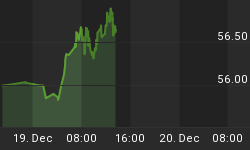In 1987, stocks peaked on August 25, and then the S&P 500 fell -36% by October 20 with a -20.5% drop on Black Monday October 19. What conditions made this possible, and are we setting up for another 1987 déjà vu crash? Look at the amazing similarities:
1. The percentage of bulls in the Investor Intelligence data has recently exceeded 50% for 46 consecutive weeks, the longest period by almost 2 times in the last 40 years of Investor Intelligence data! 1987 saw 20 weeks above 50% bulls, but they were not consecutive. Furthermore, the percentage of bears has been in the low 20s and teens for 46 consecutive weeks. The last time these low percentages of bears occurred was also before the 1987 crash.
2. The old volatility index VIX (now VXO) bottomed at 15.53 before the 1987 crash. VXO recently bottomed at 13.88 on 4/5/04, and the new VIX bottomed at 13.80 on 2/27/04, which confirms the above extreme investor optimism.
3. The P/E ratio for S&P 500 peaked at 22 in 1987 and is currently 23 using GAAP trailing earnings.
4. Starting 5 months before stocks peaked on 8/25/87, the 30-year Treasury bond price fell -14% in 10 weeks in wave A down, as shown in the charts below. After touching its 20-week moving average in a wave B up, it made new lows in a wave C down and started the 1987 crash in bonds and stocks. Starting in June 2003, 30-year bond prices fell -15% in 9 weeks, but they then rallied above their 20-week moving average for a longer period than wave B up in 1987, which is one major difference. However, now that wave 3 down has likely started, what will happen this time when bond prices make new lows and interest rates make new highs?

5. After bonds peaked in March 1987, S&P 500 rallied another 16.6% in 23 weeks. Since bond prices peaked in June 2003, S&P 500 has rallied another 18% in 38 weeks, slightly higher than 1987 but over a longer time period.
6. When bond prices started their wave C down in late June 1987, gold stocks skyrocketed - XAU rallied 47%, and NEM rose 122% in 12 weeks! But then gold stocks crashed with S&P 500 in October 1987 as seen in the chart. Will gold stocks make a strong wave 5 up this summer as inflation fears rise with interest rates and then crash with S&P 500?

7. The US dollar peaked in early 1985 and fell about -40% going into the summer of 1987. After a short rally, it continued to fall after the crash into December 1987 before starting a new 18-month rally. Now, the US dollar peaked in July 2001 and has fallen -32% so far. Will foreign investors sell their US dollars when they sell their US bonds and stocks? Will the US dollar decline to its all-time low around 80 this summer while gold rallies to $475-$500?
8. The biggest difference is that the all of the stock indexes were making new all-time highs in 1987, and the previous 4-year cycle was bullish. Looking at the 1982-2000 bull market, the 1987 crash now looks like a small pot hole. In 2004, the S&P 500 has retraced only half of its Wave A down in 2000-2002, and its 1998-2002 4-year cycle was bearish. Plus the 4-year moving average is now pointing down and acting as resistance, in contrast to 1987 when the 4-year moving average was pointing up and acted as support for the 1987 crash. (See 4-Year Cycles and Their Warning Signs) Since we are still in a multi-year bear market, what would a crash do today to a fragile economy? Could Wave C down start with a plunge?
Except for a few differences, the parallels between now and 1987 are amazing - extreme investor optimism, overvalued prices, falling bond prices, rising interest rates, falling US dollar, and rising gold stocks. The conditions for a crash are certainly ripe, but it may not occur either. It depends on how foreign investors respond to new lows in bond prices and to rising interest rates. Do they want to get out of the US markets or stay in, and how fast do they want out? We might just see a steady decline into the Fall of 2006, just like we saw from September 2000 to October 2002 with a few interspersed multi-week bear market rallies. A strong rally in gold stocks this summer may be a strong warning of a coming crash in the fall, or the markets may surprise us and not give us any more warnings.
How about one more warning sign - a second top in the stock indexes around SPX 1160 by the end of April, but would one more warning sign ever change a bull into a bear?















